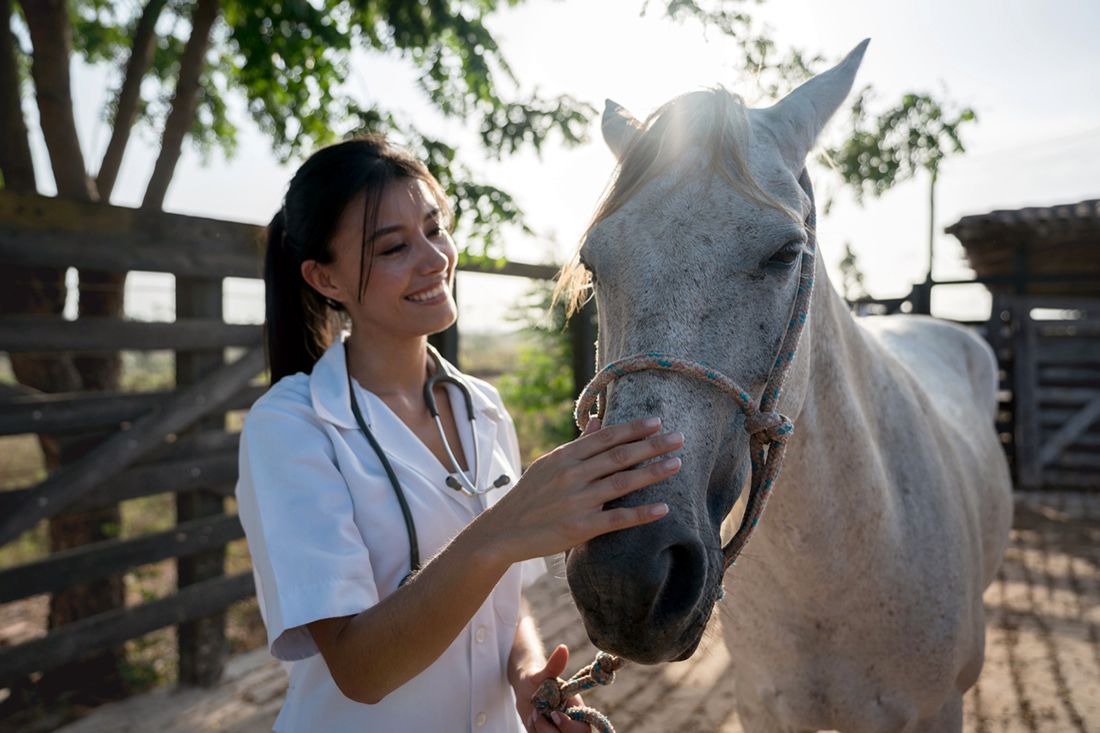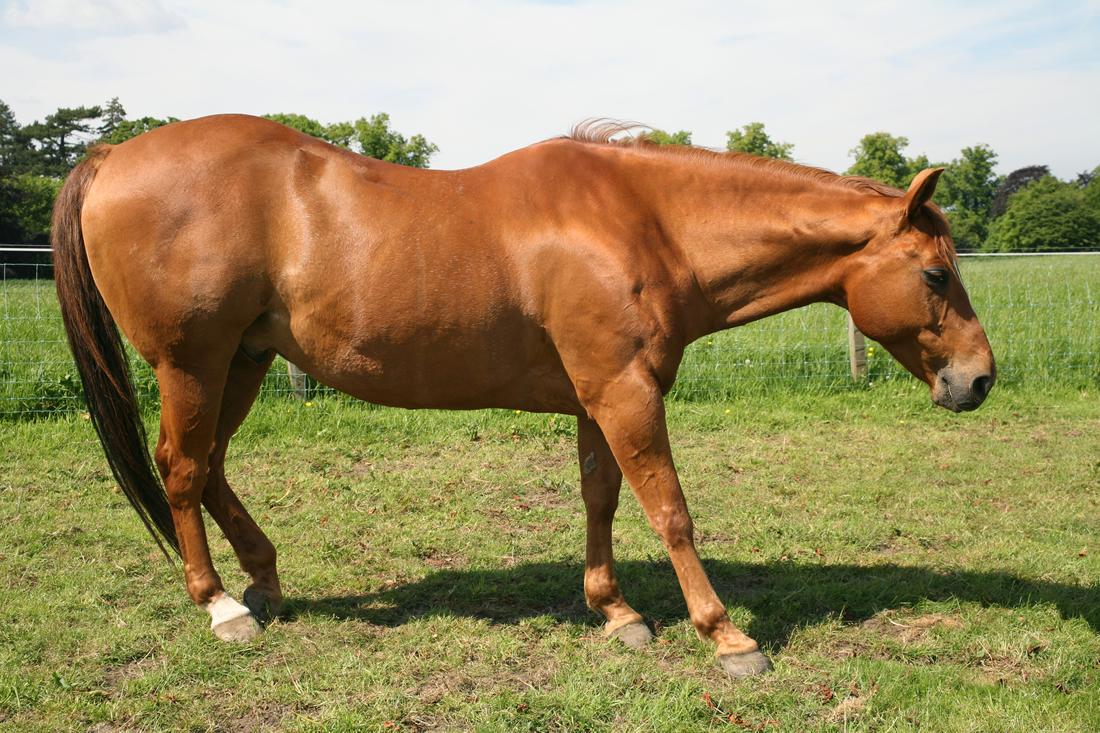Tetanus, or lockjaw, is a non-contagious neurological disease that results from a bacterial infection. Horses are particularly vulnerable to tetanus, with individuals of all ages and breeds affected worldwide.
Tetanus spores are particularly dangerous for horses as they survive for long periods and can be found everywhere in the environment, including in soil, dust, manure and even the digestive tract. [1][2][3]
The smallest wound can make a horse susceptible to tetanus once these spores enter the body. Fortunately, tetanus is entirely preventable with regular immunization and other protective measures. [4]
Treatment of tetanus involves the administration of antibiotics, antitoxins, tranquillizers or other medications to minimize clinical signs and make the horse more comfortable. [3]
The prognosis for affected horses is generally very poor, often resulting in death or euthanasia. However, the outcome depends on individual factors, including vaccination status and the supportive care provided. [5]
Tetanus in Horses
Tetanus is a bacterial disease that is frequently fatal in horses and humans without quick medical intervention. Horses are more sensitive to tetanus infection than most other animals including cattle, dogs and humans. [2]
The infection is caused by the spores of the Clostridium tetani bacterium, which can be found throughout the environment. All soils worldwide are presumed to be contaminated with C. tetani to some degree. [5]
These spores enter the horse’s body through deep wounds, although horses with superficial wounds are also at risk of infection. Horses with ulcers or wounds in the gastrointestinal tract can be infected after ingesting infected feces. [3]
Under anaerobic (low oxygen) conditions, as found in wounds, these spores create a potent neurotoxin called tetanospasmin (TeNT) and a hemolysin called tetanolysin.
TeNT causes uncontrollable muscle contractions and spasming in the body by blocking neurotransmission. Tetanolysin causes tissue necrosis (death), which ensures anaerobic conditions and proper breeding grounds for bacteria. [1][5]
Gastrointestinal Tract
C. Tetani spores can be found in the horse’s gastrointestinal tract, where they can survive undetected for long periods of time without causing infection or clinical signs in the horse. These spores can spread between animals through feces. [3]
If a horse with gastric or intestinal ulcers ingests C. Tetani from another horse’s feces, bacteria can enter circulation in the body through these wounds. It has been suggested that 10-20% of horses have C. Tetani in their feces. [6]
Maintaining a healthy gastrointestinal tract and preventing ulcers may help ward off tetanus infection by limiting entry sites into the circulatory system.

Clinical Signs
The incubation period for tetanus infection is approximately 7-8 days, but individual cases can vary anywhere between 3 and 28 days.
The following signs and symptoms can suggest the horse has tetanus: [1][4][5]
- General stiffness
- Muscle spasms (ranging from mild to severe)
- Difficulty chewing, swallowing and drinking
- Prolapse of third eyelid
- Hyperesthesia (sensitivity to touch)
- Sweating & fever
- Convulsions
- “Sawhorse” stance
- Respiratory arrest
- Death
If your horse is showing signs of tetanus, contact your veterinarian immediately for an examination.
Third Eyelid Prolapse
The third eyelid, or nictitating membrane, is found under the horse’s other eyelids on the inside corner of the eye. This layer of the eyelid offers extra protection against trauma and can extend upwards in response to irritation or inflammation. [7]
A common clinical sign of tetanus is the protrusion of this pink tissue from the corner of the eye, otherwise known as third eyelid prolapse.
In the early stages of the disease, the third eyelid can briefly prolapse after being touched. The tissue will extend across the other parts of the eye and become clearly visible when touched before gradually returning to its natural position. [7][8]
As the disease advances, eye prolapse may become permanent.
Muscle Spasms
In advanced cases of tetanus, spasms begin to involve the neck and throat, inhibiting the horse’s ability to swallow. [8]
Muscle spasms can also disturb the respiratory and circulatory systems, increasing the horse’s heart rate and breathing rate. This may lead to mucous membrane congestion and, consequently, respiratory failure and death. [8]
Risk Factors
Several risk factors are associated with tetanus in horses. Deep puncture wounds (commonly to the sole of the foot, lower leg muscle or head), crushing wounds, lacerations and surgical incisions can easily be contaminated by infectious spores. [1][5][8]
Exposed tissues, such as the umbilicus (or navel) in newborn foals, are also susceptible to tetanus infection, but this is uncommon.
Geographic location also influences tetanus risk. C. Tetani can be found in soil from all parts of the world, with a higher presence in warm and humid regions such as Africa, Southeast Asia, India and the Southern United States.
Areas with cooler weather, such as Canada, Norway, England and Sweden, have a lower prevalence of tetanus cases. The soil from the northern section of the Rocky Mountains contains hardly any C. Tetani organisms, which makes tetanus incredibly rare in this area. [2][3]
Prevention
The best way to reduce your horse’s risk of developing tetanus is by staying up-to-date on tetanus vaccinations.
Vaccines provide protection against life-threatening diseases in horses. Four core vaccines are recommended to prevent serious illnesses in horses, including: [9]
- Rabies
- Tetanus
- West Nile Virus
- Eastern Equine Encephalitis (EEE)
These vaccines are safe and effective against endemic or highly infectious diseases, which justifies their use for the majority of horses. [10]
Tetanus Vaccine (Toxoid)
The tetanus vaccine for horses, also known as tetanus toxoid (TT), is a toxoid vaccine that provides artificial active immunity against tetanus infections.
This vaccine is made by chemically inactivating the tetanus toxin, producing a toxoid that cannot cause disease. When administered to the horse, the toxoid stimulates an immune response against the tetanus toxin without harming the horse.
Once properly vaccinated, the horse is now protected with an antitoxin that neutralizes any tetanus toxin in the body. [11]
All available vaccines are formalin-inactivated and safe. They induce long-lasting active immunity, which prevents tetanus infection from developing in the horse. [1]
It is important to note that the immune response to the tetanus toxoid can vary between horses. Immunity to tetanus infection may not last the full 12 months between boosters.
Adult Horses
It is generally recommended that all adult horses receive a two-dose vaccination series using a tetanus toxoid twice (3 – 6 weeks apart), followed by an annual booster shot.
If a horse undergoes surgery or sustains a wound more than six months after their last booster, immediate re-vaccination is recommended. [10]
Horses that survive tetanus do not have extra antibodies or immunity to the disease and remain susceptible to C. Tetani and TeNT. Tetanus survivors should be vaccinated yearly.
Foals
For the first 3 – 4 months of life, a foal relies on protective immunoglobulins absorbed from the mare’s colostrum for immunity. Colostrum or “first milk” is the creamy and yellow fluid excreted from the mare’s udder immediately after birth. [12]
Colostrum provides the foal with important maternal antibodies that protect against infectious diseases, including tetanus. Within the first 12 hours of life, the foal should receive approximately 2 pints of milk from their mare. [12]
Foals that are born to unvaccinated mares are more susceptible to tetanus infection as they lack some antibodies. If the newborn foal does not receive a sufficient passive transfer of antibodies from the mare’s colostrum, your veterinarian may elect to administer the tetanus antitoxin at birth.
It is generally recommended that foals receive a three-dose series of the tetanus toxoid: [13]
- First dose between 1-4 months of age
- Second dose 4 weeks after 1st dose
- Third dose 4 weeks after 2nd dose
Foals of recently vaccinated mares should receive the tetanus toxoid at 3, 4 and 6 months, once passive immunity has diminished. This is followed by an annual booster. [10]
Pregnant Mares
Pregnant mares should be vaccinated with the tetanus toxoid 4-6 weeks before foaling. This helps protect her from any foaling-induced trauma or wounds and provides the foal with antibody protection against bacteria. [14]
Preventing Injury and Infection
While vaccination is the strongest line of defense against tetanus, avoiding injury is also important to minimize the risk of infection.
If your horse is wounded, thoroughly rinse and clean the area with antibacterial soap to disinfect and prevent tetanus infection. Administer appropriate first aid care.
Always ensure that paddocks, stalls and pastures are free of debris and materials that could potentially harm horses and lead to infection. This includes but is not limited to rusty metal, old farm equipment and sharp edges on fences, feeders and waterers.
Diagnosis & Treatment
Diagnosing a horse with tetanus is typically straightforward based on the presence of clinical signs and wound history. In some cases, clinicians may take a blood sample from the affected horse to test for the presence of tetanus toxin. [8]
Immediate attention is required following diagnosis. Horses that are recovering from tetanus require extensive supportive care and should be carefully monitored. [3]
Administration of Antitoxin
Regardless of the horse’s vaccination status, your veterinarian will usually inject your horse with tetanus toxoid following diagnosis. This will increase the neurotoxin antibodies in the body and improve the prognosis. [8]
Injecting large amounts of antitoxin (50,000 – 200,000 IU) into the subarachnoid space or the area surrounding the brain and spinal cord is a common treatment for tetanus. [15]
However, treating the horse with repeated, large doses of antitoxin will only neutralize toxins circulating in the blood and not those that are already attached to the neuromuscular system. This makes results extremely variable, depending on the incubation period and immune response of the individual horse. [11]
Caution must be taken when administering the antitoxin intravenously as a treatment, as it has the potential to induce anaphylaxis or hypersensitivity. [3]
Antibiotics
Penicillin, streptomycin and metronidazole are often used to treat tetanus. They can kill the vegetative form of C. Tetani, preventing the bacteria from multiplying and producing more neurotoxin (TeNT) in the body.
Broad-spectrum antimicrobials may also be used. [15]
Antibiotics are commonly administered alongside antitoxin to prevent the multiplication of bacteria while the antitoxin neutralizes toxins circulating in the blood.
Muscle relaxants, tranquilizers and sedatives
Clinicians may administer phenothiazine tranquillizers (acepromazine and chlorpromazine) to sedate recovering horses and reduce muscle spasms. This treatment is cost-effective and has little risk of adverse effects. [4]
Tranquillizers relax skeletal muscles while allowing the horse to remain standing. These drugs will not impair respiratory function or reactions to external stimuli.
After several injections, mild to moderate muscle spasming can be relieved. However, phenothiazines have little effect on severe spasms and seizures.
Horses with advanced forms of tetanus may respond to diazepam treatment alone or in combination with xylazine.
Diazepam in combination with chlorpromazine can be administered to reduce seizures and hypersensitive reactions in equine patients. [15]
Supportive Care
Loud sounds, bright lights, excitement in their surroundings and touch can make symptoms worse, and overstimulate affected horses.
Horses undergoing tetanus treatment should be kept in a quiet, dark stall. This may help prevent anxiety and reduce muscle spasms. [15]
Horses with tetanus are often stiff and unable to bend down. All food and water sources in the stall should be kept at a height that allows use without having to move the head up or down.
In severe cases, affected horses may be held up in a sling if they are struggling to stand on their own. Nasogastric intubation or intravenous (IV) infusion may be required to prevent dehydration in horses that are unable to drink. [16]
Prognosis
The mortality rate for horses that contract tetanus is up to 80%.
The likelihood of survival depends on the horse’s immune function, vaccination status and incubation period before treatment begins. Underweight horses may also have a poorer prognosis. [4][5][17]
Horses that survive and stand for the first 7 – 10 days of the disease have a better prognosis. In these cases, recovery from tetanus can take approximately 2 – 6 weeks. [8][16]
References
- Tetanus in Horses. Ontario Ministry of Agriculture, Food & Rural Affairs.
- Popoff, M. R .Tetanus in animals. J Vet Diagn Invest. 2020.
- Stämpfli, H. R. Tetanus in Horses. Merck Veterinary Manual. 2019.
- Green, S. L. Tetanus in the Horse: A Review of 20 cases (1970 to 1990). J Vet Intern Med. 1994.
- Kay, G. & Knottenbelt, D. C. Tetanus in equids: A report of 56 cases. American Association of Equine Practitioners (AAEP). 2007.
- Roper, M. H. Vaccines (Sixth Edition). Elsevier. 2013.
- Gelatt, K. N. Eye Structure and Function in Horses. Merck Veterinary Manual. 2022.
- Gračner, D. A twenty-year retrospective study of tetanus in horses: 42 cases. Veterinarski Arhiv. 2015.
- Guidelines for the Vaccination of Horses. Ontario Ministry of Agriculture, Food and Rural Affairs.
- Tetanus. American Association of Equine Practitioners.
- Jansen, B. C. & Knoetze, P. C. The immune response of horses to tetanus toxoid. Onderstepoort J. vet. Res. 1979.
- Fairfield, B. T. Collecting Colostrum. American Association of Equine Practitioners. 2016.
- Rood, K. A. Equine Immunity, Vaccination Guidelines and Recommendations. Utah State University cooperative extension. 2008.
- Barnett, C. D. Guidelines for Vaccination of Horses. American Association of Equine Practitioners (AAEP). 2001.
- Stämpfli, H. R. Tetanus in Animals (Lockjaw). Merck Veterinary Manual. 2021.
- Vörös, K. Clinical signs and treatment of equine tetanus. Magyar Allatorvosok Lapja. 2001.
- Ribeiro, M.G. et al. Tetanus in horses: an overview of 70 cases. Pesq Vet Bras. 2018.












Leave A Comment